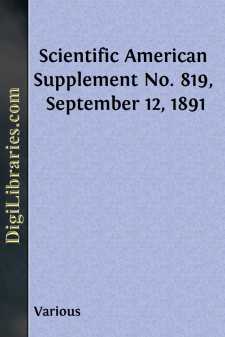Categories
- Antiques & Collectibles 13
- Architecture 36
- Art 48
- Bibles 22
- Biography & Autobiography 813
- Body, Mind & Spirit 142
- Business & Economics 28
- Children's Books 16
- Children's Fiction 13
- Computers 4
- Cooking 94
- Crafts & Hobbies 4
- Drama 346
- Education 46
- Family & Relationships 57
- Fiction 11829
- Games 19
- Gardening 17
- Health & Fitness 34
- History 1377
- House & Home 1
- Humor 147
- Juvenile Fiction 1873
- Juvenile Nonfiction 202
- Language Arts & Disciplines 88
- Law 16
- Literary Collections 686
- Literary Criticism 179
- Mathematics 13
- Medical 41
- Music 40
- Nature 179
- Non-Classifiable 1768
- Performing Arts 7
- Periodicals 1453
- Philosophy 64
- Photography 2
- Poetry 896
- Political Science 203
- Psychology 42
- Reference 154
- Religion 513
- Science 126
- Self-Help 84
- Social Science 81
- Sports & Recreation 34
- Study Aids 3
- Technology & Engineering 59
- Transportation 23
- Travel 463
- True Crime 29
Scientific American Supplement No. 819, September 12, 1891
by: Various
Categories:
Description:
Excerpt
THE STORY OF THE UNIVERSE.
By Dr. WILLIAM HUGGINS.
The opening meeting of the British Association was held in Park Hall, Cardiff, August 18, where a large and brilliant audience assembled, including, in his richly trimmed official robes, the Marquis of Bute, who this year holds office as mayor of Cardiff. At the commencement of the proceedings Sir Frederick Abel took the chair, but this was only pro forma, and in order that he might, after a few complimentary sentences, resign it to the president-elect, Professor Huggins, the eminent astronomer, who at once, amid applause, assumed the presidency and proceeded to deliver the opening address.
Dr. Huggins said that the very remarkable discoveries in our knowledge of the heavens which had taken place during the past thirty years—a period of amazing and ever-increasing activity in all branches of science—had not passed unnoticed in the addresses of successive presidents; still, it seemed to him fitting that he should speak of those newer methods of astronomical research which had led to those discoveries, and which had become possible by the introduction into the observatory, since 1860, of the spectroscope and the modern photographic plate. Spectroscopic astronomy had become a distinct and acknowledged branch of the science, possessing a large literature of its own, and observatories specially devoted to it. The more recent discovery of the gelatine dry plate had given a further great impetus to this modern side of astronomy, and had opened a pathway into the unknown of which even an enthusiast thirty years ago would scarcely have dared to dream.
It was now some thirty years since the spectroscope gave us for the first time certain knowledge of the nature of the heavenly bodies, and revealed the fundamental fact that terrestrial matter is not peculiar to the solar system, but is common to all the stars which are visible to us. Professor Rowland had since shown us that if the whole earth were heated to the temperature of the sun, its spectrum would resemble very closely the solar spectrum. In the nebulæ, the elder Herschel saw portions of the fiery mist or "shining fluid," out of which the heavens and the earth had been slowly fashioned. For a time this view of the nebulæ gave place to that which regarded them as external galaxies—cosmical "sand heaps," too remote to be resolved into separate stars, though, indeed, in 1858, Mr. Herbert Spencer showed that the observations of nebulæ up to that time were really in favor of an evolutional progress. In 1864 he (the speaker) brought the spectroscope to bear upon them; the bright lines which flashed upon the eye showed the source of the light to be glowing gas, and so restored these bodies to what is probably their true place, as an early stage of sidereal life. At that early time our knowledge of stellar spectra was small. For this reason partly, and probably also under the undue influence of theological opinions then widely prevalent, he unwisely wrote in his original paper in 1864, that "in these objects we no longer have to do with a special modification of our own type of sun, but find ourselves in presence of objects possessing a distinct and peculiar plan of structure." Two years later, however, in a lecture before this association, he took a truer position....












